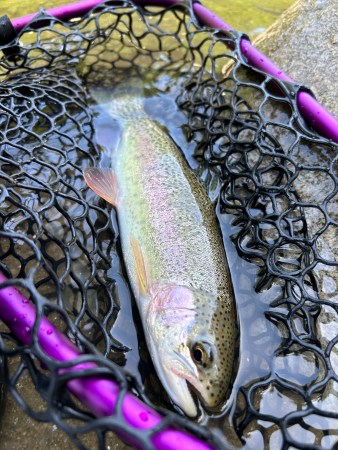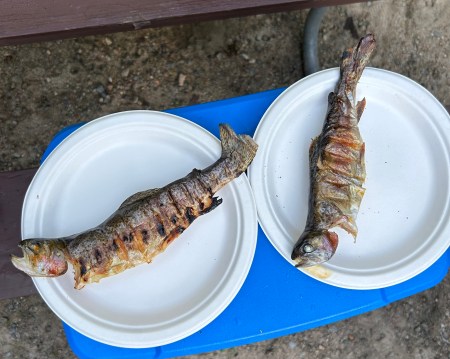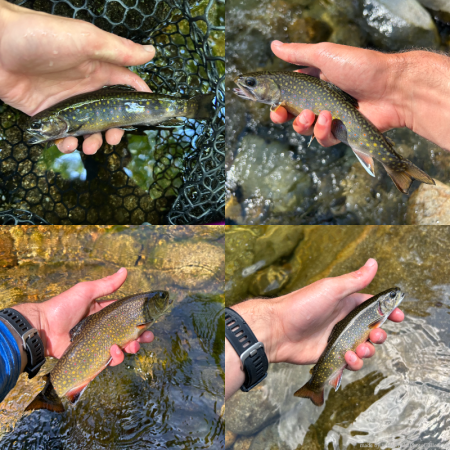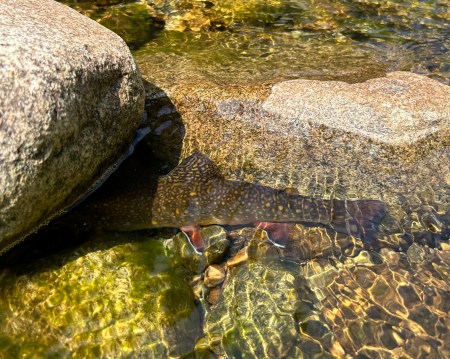Thanks to a Native Fish Coalition rendezvous in the White Mountains last weekend, my four-year dry spell of fishing in the region has finally ended. Some of my earliest memories of fly fishing and conservation come from these mountains, where I spent my summers exploring the woods and waters of northern New Hampshire at Barry Conservation Camp in Berlin (see if you recognize anyone in this video).
Driving up Route 16, I was in awe of the towering cliffs and cascading streams in the mountains past North Conway. When I arrived at the campsite, I was greeted by a friendly group representing five of the sixteen states NFC has a presence in. Though great fishing surrounded us, we relaxed by the campfire that evening, preparing for the marathon of a day ahead.
At about 2:30 that night, I was awoken by aggressive shouting from the next campsite over. “Get outta here! Scram!” Suddenly, an air horn pierced the tranquil silence of the night, creating a flurry of opening tent doors and confused campers.
From the safety of my tent, I heard one of the members of our NFC group call out, “What’s going on?”
“Bear,” the air-horn-wielder replied nonchalantly, retreating to the confines of his RV. But the warning sent the rest of the campground into a flurry lasting throughout the rest of the night. Needless to say, I didn’t get much sleep.
By the time 4:45 AM rolled around, I decided I’d had enough. I crawled out of my sleeping bag and prepared some oatmeal and bacon. After a short drive down the road, I was glancing out over a large, rock-strewn river, picturesquely framed by the Presidential Range and rising sun. Having next to no intel on the region’s fisheries, it seemed like as good a place as any to start.
The nature of most White Mountain rivers is shallow, bouldery, and largely featureless, with an open canopy and extensive flood plain. This river was no exception, except a large pool below the bridge crossing broke up the uniformity. I flung a Chubby Chernobyl / Walt’s Worm dry-dropper combo into the pool and watched as the Chubby was quickly submersed. The fish felt nice, much heftier than the small, native brookies I’d expected. Eventually, an 11 inch rainbow trout slid into my new Rising net. I knew there are wild ‘bows in the Whites, but this seemed like a particularly large specimen to be wild. Still, the fins were clean and white-tipped, the adipose intact, and the body lean and muscular, not fat like a pellet pig’s. I released the fish, optimistically reasoning I had just stumbled into a wild trout honey hole.

Successive casts yielded many more rainbows, all around the same size as the first. They took both the dry and the nymph, and even the jig streamer I eventually tied on. The sheer number and cookie-cutter size of these fish told me they were in fact stocked, an all-too-frequent practice in New Hampshire rivers where wild trout already thrive.
Leaving the stocker hole, I ventured upstream and into a small, wooded tributary. Here I caught a couple of indisputably wild, native fish, a handsome pair brook trout. These were dark fish, their grayish-blue parr marks and bright spots boldly contrasting their deep green flanks. Satisfied, I headed back downstream, catching a couple more rainbows along the way. As the first rays of golden sunlight crept out over the high peaks, I called it a morning.

In the early afternoon, Bob Mallard, NFC’s Executive Director; Brian Crowden, NFC’s Vice Chair – North, and I (a lowly Massachusetts board member) left camp to fish an upstream section of the river I’d fished in the morning. In order to cover a large swath of water, we dropped one car at a picnic area and drove the other a mile upstream, accessing the river via a trailhead.

Despite the recent onslaught of rains to boost flows, the water remained exceptionally clear. As I jigged my streamer through the first hole, I watched with great excitement as a small brook trout shot out from behind a rock and engulfed the fly. The patterns on this fish were duller than the earlier ones, and a chunk missing from its gill plate made it obvious that it was raised in a concrete tank. Where other states would grimace at the thought of stocking brook trout anywhere near their wild, native counterparts, New Hampshire does it excessively, planting tank scrubbers where natives already thrive. In fact, upon further research, the stretch we were fishing had received over 1,000 stocked brook trout just a month earlier. Granted, these are infertile streams where trout size would naturally top out at about 10 inches. But these aren’t large fish NH F&G are stocking; they are year-olds in the five-to-eleven-inch range. All this is to say: the excessive stocking of rivers in the White Mountains is silly, especially in a National Forest created to preserve a healthy, natural ecosystem.
As I got lost in a flurry of conservation thoughts, I was quickly losing Bob and Brian. For those who don’t know him, Bob fishes fast. Very fast. Brian and I spent much of the day chasing Bob, who was making very efficient work of the 1+ miles of stream we were to cover. He didn’t even seem deterred by the maze of rounded stones scouring the stream bed, which wreaked havoc on my apparently-weak ankles.
Though we moved fast, we caught plenty of fish, undoubtedly helped by the recent stocking. Bob would typically start as our prospector, working any slot, pool, or undercut bank with a small, foam, rubber-legged bug. About half the time a fish would come up and clobber the offering. Occasionally a fish would come up and miss the skittering fly, or there would be no sign of fish at all. In these cases, it was Brian or my turn to work the spot with our bright, flashy streamers, often tempting a fish that the dry fly had failed to entice. As we worked our way downstream, fish size gradually increased, until we were catching 12-inchers right by the takeout. Pleased with our success, we returned to camp.

Later that evening, NFC’s Massachusetts Chair, Bob Dalton, arrived. He wanted to get on some fish before the last of the light faded, so I took him down to the roadside pool where I’d had luck in the morning. As promised, we found some quick fish, he using a terrestrial, and I fishing a Frenchie under an indicator. Each of our last trout met an unfortunate fate, destined for the grill for tomorrow’s breakfast. It was the first fish I’d kept in over three years, and admittedly the killing part hadn’t gotten any easier. But as Bob put it, by keeping a couple of nonnatives, we were doing our small part for the river.
Following another bear visit that night, we enjoyed a fantastic surf-and-turf breakfast before hitting the road early on the morning of our final day. The grilled trout went great with a venison steak from a deer Bob D shot last fall. Between the steak, backstrap, meat sticks, and sausages, I can honestly say I had more venison that weekend than I had in my entire life.

By 8:00 AM Bob D and I were on the road, fishing our way back to Massachusetts. Our first stop was at a deep downstream pool on the same river we had fished the previous day. With the air temperatures already in the 70s by the time we hit the water, I think both of us were strongly considering leaving the rods behind and jumping in the cold, clear water. Thankfully we stuck it out, and the pool yielded a few rainbows. I even managed to catch one on a swung Partridge & Yellow soft hackle, a technique I definitely don’t employ enough.
Within an hour our cars were once again pointed south towards home. Before we left the wilds of the mountains and hightailed it on the highway, though, we made a stop at one last stream. The water here was just as clear as the previous river, but a little smaller and more intimate. We anticipated finding a few fish, but the epic couple of hours we had was anything but expected.
Starting off with a Purple Haze, my small stream stand-by, I immediately hooked a small brook trout in the first pocket I plied. The trout was small – maybe three inches – with crisp, white-rimmed fins and an olive/burnt orange belly. Though I have no photographic evidence, I’d like to imagine this was a wild fish.
While Bob stayed back to work some downstream pockets, I traveled upstream. Subsequent pockets held plenty more fish, eventually decommissioning my Purple Haze after numerous desiccant applications. Most of the brookies I caught were in the cookie-cutter eight-to-nine-inch range, with salmon-pink bellies and slightly ragged fins. As I caught more and more of these cookie-cutters, I realized that was the telltale sign between stocked and wild fish – the color of the belly. If there was even the slightest hint of a salmony, orange/pink color along the belly to the caudal fin, I determined it was a stocked trout. If the belly was olive, burnt orange, or pearly white with long, crisp fins, it was likely a wild fish. Not exactly the most scientific method, but I’m fairly confident in my findings.

Another observation about stocked brook trout – they’re about as good at camouflage as a four-year-old hide-and-go-seek player. Each time I released one, it would bury its head in the rocks just inches from my boots, as if I couldn’t see it if it couldn’t see me. Then they would sit there for minutes – one time I spent five minutes re-rigging, and the same fish was still sitting right where I’d released it by the time I’d tied on the new fly.

The next fly up to bat was a small Klinkhammer. The Klink ended up catching more rainbows than brookies which, upon further investigation, were all wild. Baby blue parr marks accented their pink lateral lines, and a metallic lavender highlighted their cheeks. These ‘bows were acrobats, launching themselves many feet in the air after being hooked. Most of the time, the larger the fish, the higher the jump.
Soon the Klinkhammer, too, struggled to stay afloat. Peering through my box, I spied a gaudy, orange deer hair bug that I never had any intention of fishing, but I figured What the heck – if the fishing’s this silly, I may as well show them something even sillier. Surprisingly, on the first cast, a big wild rainbow came up and sucked the fly down. Then another. And another. It seemed the fish didn’t care what I was throwing – they were hungry!

In time Bob caught up to me, but I hesitated to share my great success; I feared he hadn’t found the same fortune. But when he looked at me, smiled, then started laughing with jubilation, I knew we’d both hit the jackpot. We settled into a long, shallow pool, and I quickly hooked the nicest fish so far, a salmon-bellied brookie of about 11 inches. Bob followed suit on a chewed-up ant pattern. We then went cast-for-cast, slowing down to film and take pictures when we realized we were in the perfect location for an impromptu photo shoot. Bob even let me try his rod, a 6-foot, 3-weight fiberglass that bent all the way to the cork when I hooked a respectable brookie.


It was hard to leave biting fish, especially when we’d only worked a 200 yard stretch of river. Still, we both had responsibilities at home, so we pried ourselves from the pool and turned back downstream. As we waded, I danced my fly in all the pockets we’d fished on the way up, finding a fresh fish in each. It seemed there was no end to the trout in this stream!
A venison sausage sandwich for lunch seemed like a fitting send-off to our wildly successful White Mountain rendezvous. As I drove south on 93, crossing mountain ranges, notches, and rivers as I went, I made an interesting observation about the water coming from New Hampshire’s tallest mountains: it flows in all different directions. Well duh, Spencer! It doesn’t exactly take a genius to figure that out!
But think about it this way: there are five major watersheds in New Hampshire – the Connecticut, the Merrimack, the Piscataqua, the Androscoggin, and the Saco. Of those five, four – all but the Piscataqua – have headwaters in just the Presedential Range alone. The distance separating these massive watersheds is infinitesimal, and yet they flow into the Atlantic Ocean hundreds of miles apart. For instance, a raindrop that lands on the northern face of Mount Washington might end up in Brunswick, Maine, while a drop that lands 20 feet to the west would flow through Hartford, Connecticut. My grandfather often quips that the entire state of Maine gets its water from the western mountains. Well, if that’s the case, then all of New England gets its water from the White Mountains.
Just a fun little brain teaser for your Monday morning.


Great article, Spencer. I really enjoyed it. Bill
LikeLiked by 1 person
Thanks Bill! Hope Georgia is treating you well.
LikeLike
Awesome article! Glad you found such crazy success!
LikeLiked by 1 person
Thanks Allan! It was a blast!
LikeLike